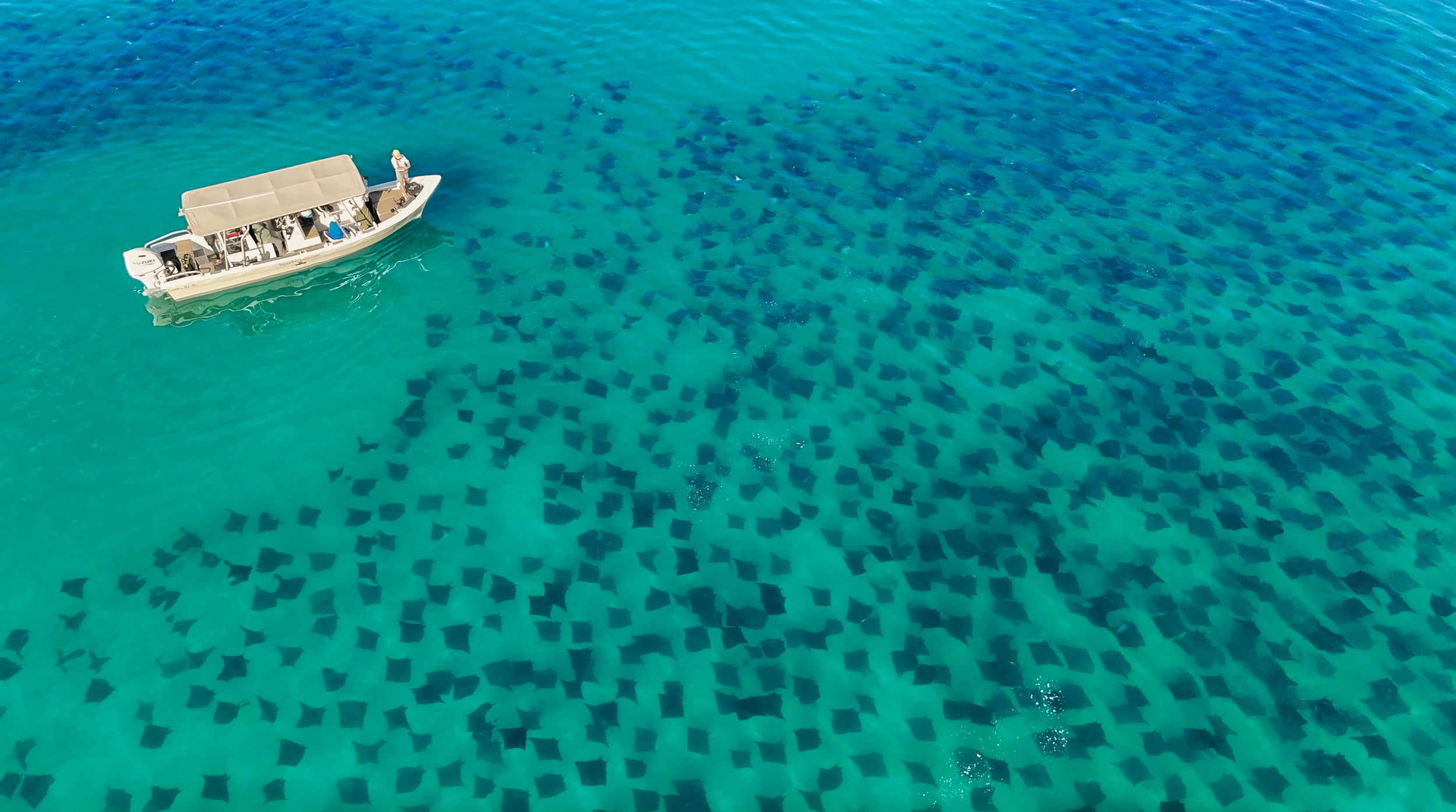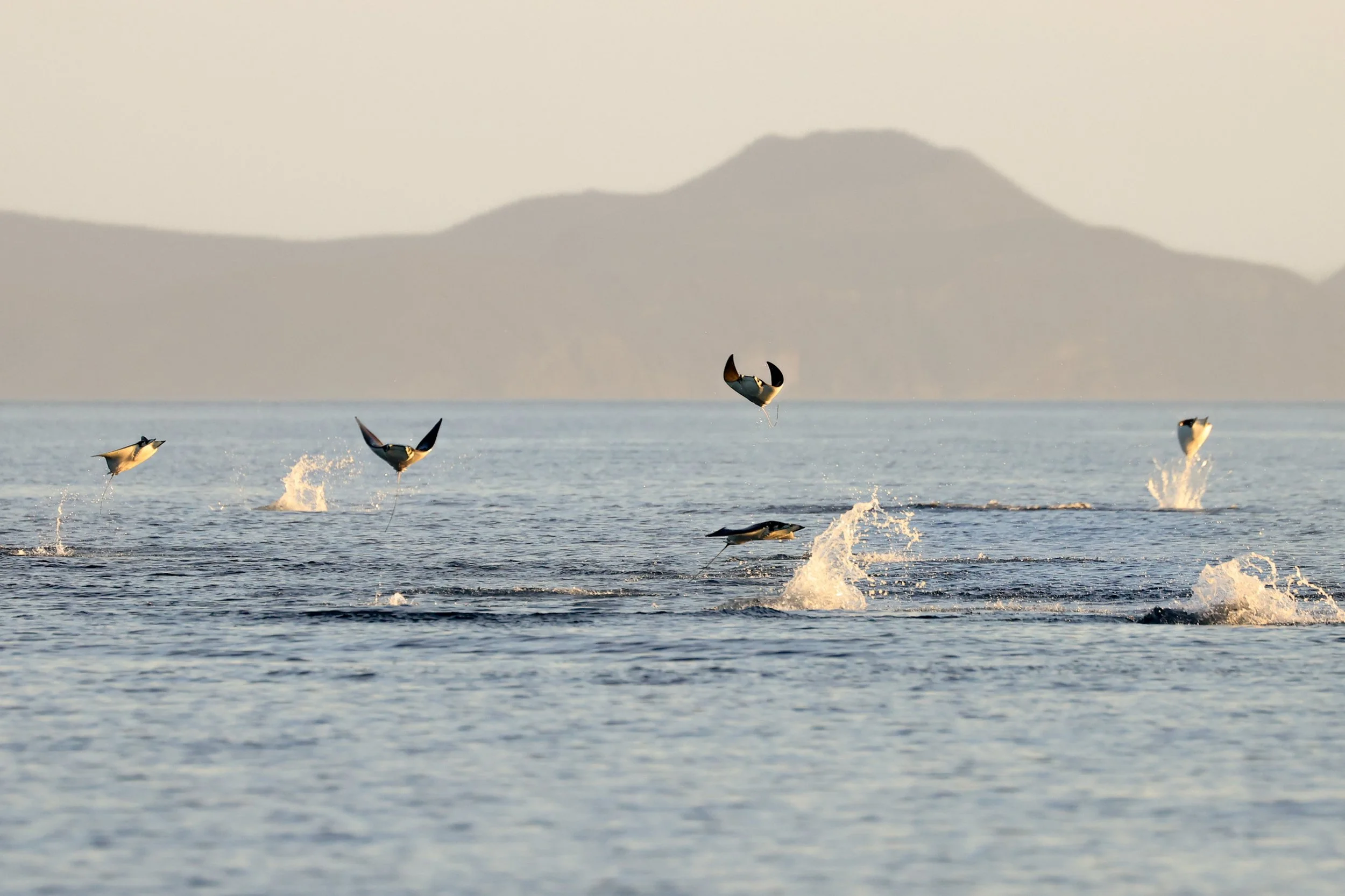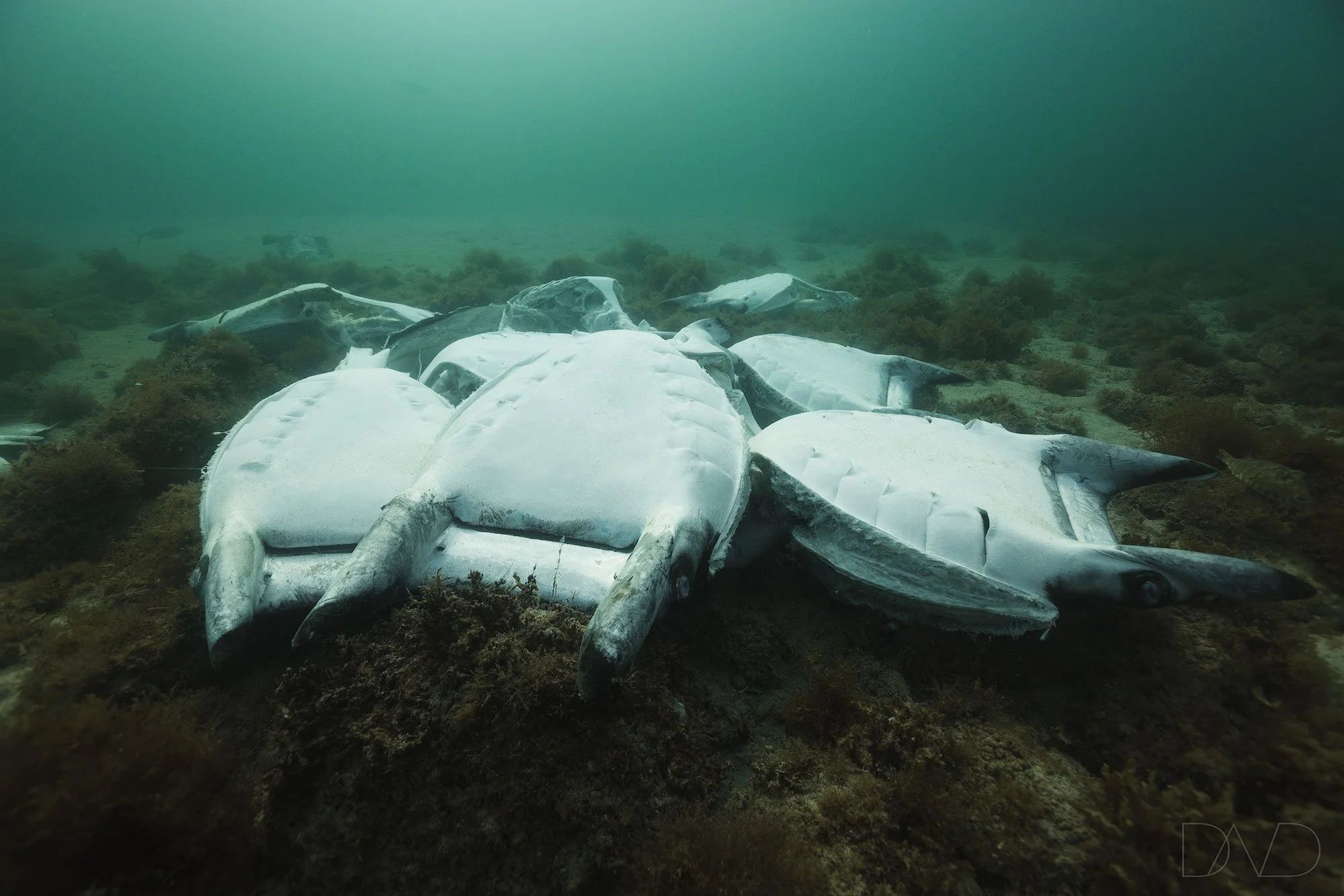Baja Adventures finds massive linear aggregation of mobula munkiana in Loreto this July
Baja adventures expedition boat amidst a stunning aggregation of mobula munkiana in Loreto
Located on the eastern coast of the Baja California Peninsula, Loreto sits along the pristine, protected waters of the Gulf of California—a vibrant sea often called the “aquarium of the world” for its extraordinary biodiversity.
Loreto is a small, charming village framed by the dramatic Sierra de la Giganta mountains and crystal-clear turquoise seas. Unlike the mass tourism destinations farther south, Loreto offers a peaceful, authentic experience with a close-knit community that values its natural heritage. Its protected marine park and unspoiled coastline make it a sanctuary for wildlife and a paradise for travelers seeking genuine connection with nature and culture.
In July, the combination of clear waters, abundant plankton lead by the upwelling of nutrient-rich water, and warm temperatures sets the stage for spectacular wildlife encounters, including gatherings of mobula mukiana, mobula birostris, rays, dolphins, bryde’s whales and other marine species that call this unique corner of Baja home.
Baja adventures boat tour amidst a stunning aggregation of mobula munkiana in Loreto
Just three days ago, our team at Baja Adventures and Nakawe Project together with our expedition participants were privileged to witness the largest linear aggregation of Mobula munkiana, or Munk’s devil rays, ever recorded in Loreto Bay National Marine Park. Hundreds of these elegant rays breached and swam together in a remarkable, road-like formation in the shallow, crystal-clear waters of the bay—a breathtaking display that speaks volumes about the resilience of this species and the success of conservation efforts in the region.
About Mobula munkiana: The Smallest Mobula with a Big Presence
Mobula munkiana breaching in Loreto, Baja California, Mexico.
Mobula munkiana is the smallest mature species in the genus Mobula, reaching an average disc width of 89–100 cm and weighing up to 25 kg. Endemic to the Eastern Tropical Pacific, their range extends from the Baja California Peninsula, Mexico, down to Peru, including the Galapagos Islands. These rays are often found in large schools, sometimes numbering in the thousands, especially when their preferred prey—mysid shrimps (Mysidium sp.) and euphausiid shrimps (Nyctiphanes simplex)—are abundant.
Why Mobula munkiana Leap: Understanding their breaching behavior
Mobula munkiana, leap out of the water in spectacular acrobatic displays,for several possible reasons, though the exact cause remains uncertain. Scientists suggest breaching may serve to:
Remove parasites from their skin, helping maintain health.
Communicate with other rays, possibly signaling location, safety, or social cues within their large groups.
Facilitate mating behavior, as breaches often occur in pairs or during aggregations linked to reproduction.
Assist in feeding, by stunning or concentrating plankton prey, making it easier to capture.
Express social dynamics or even simply as a playful or energetic behavior.
Mobula munkiana aggregation leaping
Their aggregations serve multiple purposes, including feeding and mating behaviors. In the Gulf of California, females segregate from males upon reaching sexual maturity, and juveniles tend to prefer warmer shallow waters
Large aggregations and their significance
Linear aggregation of Mobula Munkiana in Loreto Bay National Park.
Mobula munkiana can form aggregations of over a thousand individuals in Loreto and the Gulf of California, Mexico. A linear aggregation of Mobula munkiana, often described as a “mobula road,” refers to a striking natural phenomenon where hundreds or even thousands of these rays swim closely together in a long, narrow, road-like formation. This behavior has been observed in shallow coastal waters, such as those in Loreto Bay National Park, and is believed to serve multiple ecological and social functions.
Such linear aggregations are typically linked to:
Feeding: Mobulas gather where dense swarms of their prey—mainly mysid and euphausiid shrimps—are concentrated. Swimming in coordinated lines may improve foraging efficiency by helping them corral or locate prey more effectively.
Mating and Social Interaction: These gatherings also likely facilitate courtship and mating behaviors. Large groups increase the chances of finding mates and may support social learning and communication.
Energy Efficiency: Swimming in groups can reduce individual energy expenditure through hydrodynamic advantages, although this aspect is still being studied.
Predator Avoidance and Cleaning: Aggregations may provide safety in numbers and access to cleaning stations where parasites are removed.
According to the International Union for Conservation of Nature (IUCN), the population of Mobula munkiana is currently decreasing. This decline implies that these large groups may become smaller and less frequent, potentially affecting the energy efficiency of the rays and ultimately their survival.
Conservation success and challenges
Dead mobulas found in Baja California Sur with their wings cruelly cut off by photo Nakawe Project team
Historically, Mobula munkiana populations were heavily depleted due to fishing along the Baja California Peninsula, mainly to produce machaca, a dried shredded meat product. This exploitation severely reduced their numbers.
Thanks to increased awareness, fishing bans, and the establishment of protected areas like Loreto Bay National Park, their populations have been steadily recovering. Sustainable tourism focused on wildlife encounters is now playing a crucial role in supporting their resurgence and local economies.
Regi Domingo, our wildlife expert and freediving guide, diving among a stunning aggregation of Mobula munkiana.
Tourism involving Mobula munkiana is increasing in Mexico, making it essential to develop optimal management strategies to protect this vulnerable species. Ongoing research and outreach projects aim to raise public awareness about the importance of these aggregations and promote respectful behavior during tourist activities to minimize disturbance.
Why are they called Munk’s devil rays?
Walter Munk was a pioneering oceanographer known as the "Einstein of the Oceans"
The species name honors Walter Munk, a renowned oceanographer who contributed greatly to marine science. The “devil ray” nickname comes from their distinctive cephalic fins—two horn-like lobes on their heads that resemble devil horns. Despite the name, these rays are gentle species of the sea.
What this aggregation tells us about Loreto Bay National Park
Baja adventures boat tour amidst a stunning aggregation of mobula munkiana in Loreto
Such a large, linear aggregation indicates a healthy and productive marine ecosystem. Mobula munkiana’s presence reflects abundant planktonic prey and favorable environmental conditions, such as warm, nutrient-rich shallow waters. Their behavior provides valuable insight into their social structure and habitat preferences, helping scientists tailor conservation strategies.
Embracing the wild spirit of Loreto
The spectacular gathering of Munk’s devil rays in Loreto Bay is a hopeful symbol of nature’s resilience and the positive impact of conservation. It reminds us of the delicate balance between human activity and wildlife preservation.
Mobula munkiana breaching in Loreto, photographed by our wildlife photographer Regina Domingo.
If you’re lucky enough to visit Loreto Bay National Park and join us on a marine adventure, keep your eyes peeled for these magnificent rays breaching and gliding in unison, a true aquatic ballet and a testament to the wild beauty of Baja California Sur.
Experience the magic of Loreto’s marine life responsibly and support our ongoing conservation efforts on a regenerative tourism expedition. Every adventure with us helps keep Loreto’s waters wild and full of life.










